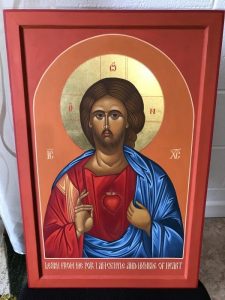
The word “icon” is a Greek word meaning image. It is the same word used in the Bible “God created man in His image” Genesis 1:27, He created man in His eikōn. Icons can only be truly understood through the doctrines of the Trinity and Incarnation. By becoming flesh, God sanctified matter. St. John of Damascus wrote: “I do not worship matter. I worship the Creator of matter who became matter for my sake, who willed to take His abode in matter, who worked out my salvation through matter”.
Through the Incarnation we understand the importance of the personal aspect of God in our salvation.
St. John of Damascus again says “It is obvious that at that time [before Christ] you could not make an image of the invisible God, but when you see the Formless One become man for your sake, then you will make images of Him in His human form. When you contemplate God becoming man, then you can depict Him clothed in human form. When the invisible One becomes visible to us, you may then draw His likeness….Paint everything with words and colours both in books and on boards”.
Act 6 of the Seventh Ecumenical Council (787) reads: “What a word communicates through hearing is what art shows silently through an image”.
The correct term is to write an icon and not to paint; it is simply because icons are theology in images. The process of writing an icon is an engagement with the Divine, it is a prayer expressed by the very process of painting. It is not a work of art, but is a way of opening the inner doors of perception to allow the Divine to flow out. It is a very subtle way of abandonment and surrender of one’s self.
The Icon board is prepared by treating it with several layers of gesso (chalk power and rabbit skin glue). Natural pigments are mixed with egg yolk diluted with vinegar and distilled water. This technique is called “tempera” and has a very long tradition.
Unlike other types of imagery, iconography address deeper levels of consciousness. In iconography the naturalistic representation of a figure is replaced with a spiritualized and transfigured being.
Human flesh as depicted in icons differs radically from the flesh that is drawn in conventional painting.
Leonid Ouspensky beautifully writes “The icon is an image of a human being truly filled with the passion-searing and all-sanctifying grace of the Holy Spirit. Therefore, his flesh is depicted as essentially different from the ordinary corruptible flesh of a human being. The icon communicates a certain spiritual reality: sober, based on a spiritual experience and completely free of any exaltation. If grace illumines the whole person so that his entire spirit, body and soul are engulfed in prayer and dwell in divine light, then the icon visibly portrays this person who has become a living icon, the likeness of God”.
The iconographer always starts with the darkest colours and finishes with the brightest ones. This symbolizes that the icon is painted with light. Light is an energy; darkness is not, it’s only the absence of light. In the same way, on our spiritual journey, we bring light that will make darkness disappear. There is a big difference between a normal portrait painting and an icon. It has to do with light again. In a normal painting there will always be an exterior source of light so that the object perceived by the eyes will be the actual reflection of the light. But in iconography is not so. The very source of the light is the person itself. This light does not come from the exterior but from within, thus illumining the entire being, flesh, garments and surroundings.
In 451 the Council of Chalcedon defined the two natures of Christ, God and man. The icon of Christ is expressing this dogma by the two different colours of His garments: red, the inner garment which symbolizes the humanity, and blue, the outer garment, wrapping the whole body in it and symbolizing Divinity. Christ wears a Stole.
The Divine state of Christ is also symbolized by the halo surrounding the head. Inside the halo we see the cross and in the cross we read the Greek letters Ο Ω Ν, making up ὁ ὢν – “ho ōn”, “He who is”.
Above Christ’s Head are the letters “IC” and “XC”, a widely used four letter abbreviation of the Greek for Jesus (IHCOYC) Christ (XPICTOC).
Frontality and eye contact indicate closeness and concentrated attention. The engagement is direct. The forehead is high, expressing both the power of the Spirit and of wisdom, which are inseparable from love. The nose is thin and elongated, giving nobility to the face. The mouth, being an extremely sensual organ, is always drawn finely and geometrically, eliminating its sensuality. The lips remain closed, because true contemplation demands silence. The ears are interiorized. This gives a clear example of the importance of kenosis – the act of self-emptying and becoming entirely receptive to God’s divine will.
Christ is blessing with His right hand and is drawing back the outer garment with His left hand to reveal His Heart.
The Heart is depicted as a flaming Heart – shining with divine light, bleeding wound (in Heart) and surmounted by the Cross. The Flames symbolise transformation, purification, energy, spiritual power – flames of Love. The radiating light and love around the Heart is the manifestation of Divinity – symbol of life, illumination – love (It is Christ consciousness)
Sr. Patricia Conway Feast of the Sacred Heart (8th June 2018)
